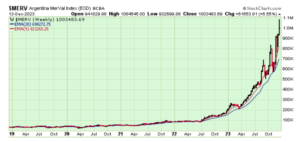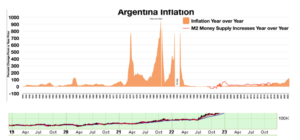ARGENTINA – LOSS OF TRUST IN A SINGLE CHART
This is an interesting discussion of the problems Milei faces in Argentina and an incredible review of an ever greater Hyperinflation which occured in Hungary in the 40s after the War
FROM BOOM FINANCE
……………………………
Loss of trust in institutions is at a severe stage in Argentina. After almost 100 years of an economic roller-coaster and financial mayhem induced by successive governments who had no clue what they were doing, the people have been in a state of panic for the last 18 months, desperately buying shares in the hope of preserving some wealth. This is what happens when the people lose trust in their banking system, the value of their homes and their national currency.
The share market index, the MerVal Index, has doubled three times in the last 18 months. It has risen from around 100,000 points to over 1 Million. That is called a “10 Bagger” in investment terms. Some naive individuals may see this as a strong vote in favour of Argentina’s corporate sector with high expectations of future prosperity. However, that is clearly not the case. Argentinians are simply terrified of the future and desperately trying to find a “safe” place for their hard earned excess funds.
That one chart says it all. Sheer desperation writ large.
The nation’s annual CPI inflation rate is currently 161 % which sounds awful but is relatively low by historical Argentinian standards. In 1989, Argentina experienced a period of hyperinflation (currency collapse), with annual inflation reaching almost 5,000 % for a short period.
Here is a chart of inflation rates in Argentina since 1944. You can see the Hyperinflation events (currency collapse) clearly. Some events are not shown as it would be impossible to fit them all into a single chart.
The current top of the pops in Annual CPI inflation is Venezuela with a current figure of 283 % while Lebanon is runner up with just 215 %.
Argentina has now elected a new President called Javier Milei who is promising yet another economic nirvana by abandoning the national currency in favour of the US Dollar, closing down the central bank, turning away from the BRICS nations and sacking many thousands of public servants. If he does all of that (he may not), a crash of the nations’ commercial banks will eventually happen due to loss of inter-bank trust if there is no central bank to act as intermediary. History tells us that. And, if that happens, a crash of the national economy is almost guaranteed. Poverty will then go from 40 % to over 70% (BOOM’s estimate). Asset prices will collapse. Productive assets will then be (presumably) sold off to “international investors” for peanuts (US Dollars borrowed for that purpose from offshore Tax Haven banks).
BOOM often says “your currency is your nation” and “your nation is your currency”. The US Dollar has been used in Argentina for so long to settle large asset transfers (such as homes and apartments etc) that it is arguable that the Nation no longer exists and has not really existed in financial terms for decades.
The sad thing is this — the people of Argentina have little choice but to take the Milei gamble. It is called a “Hail Mary” pass in American football, a last desperate attempt to win the game. Seductive Utopian, Socialist ideas and Marxist dialectic have destroyed the nation’s economy. Of course, everything was done “for the greater good”.
This appears to be a repeat of the what happened to the USSR after it collapsed in 1990 – 1999 when the so-called “Harvard Boys” – the Harvard Institute for International Development — turned up to “re-construct” the productive assets of Russia.
HYPERINFLATION – WHAT IS THAT? — CURRENCY COLLAPSE
Let’s look at the worst episode of Hyperinflation in history. It occurred in Hungary at the end of World War Two. It makes present day Argentina look like a non-event. As recorded by Wikipedia —
QUOTE: “Between the end of 1945 and July 1946, Hungary went through the highest inflation ever recorded. In 1944, the highest banknote value was 1,000 Pengo (the Hungarian currency at that time). By the end of 1945, it was 10,000,000 Pengo, and the highest value in mid-1946 was 100,000,000,000,000,000,000 Pengo. A special currency, the adópeng? (or tax peng?) was created for tax and postal payments. The inflation was such that the value of the adópeng? was adjusted each day by radio announcement. On 1 January 1946, one adópeng? equaled one peng?, but by late July, one adópeng? equaled 2,000,000,000,000,000,000,000 Pengo or 2×1021 Pengo (2 sextillion peng?).
When the peng was replaced in August 1946 by the Forint, the total value of all Hungarian banknotes in circulation amounted to 1 / 1,000 of one US cent. Inflation had peaked at 1.3 × 1016% per month (i.e. prices doubled every 15.6 hours). On 18 August 1946, 400,000,000,000,000,000,000,000,000,000 Pengo (4×1029 peng?, four hundred quadrilliard on the long scale used in Hungary, or four hundred octillion on short scale) became 1 Forint.
Start and end date: August 1945 – July 1946
Peak month and rate of inflation: July 1946, 41.9×1015 % UNQUOTE
…………..


The sad story about Hungary confirms how one goes broke:”gradually, AND THEN SUDDENLY.” What a nightmare!
The obvious answer for the Argentine people is to buy either foreign shares (not local), or if that’s not possible, to buy crypto. Lots of risk still, but less than one expects from a vaporizing currency altogether.
5. The calm after the storm is precisely why institutions feel comfortable exploring. If it didn’t die in 2022, crypto isn’t a fad. US dollar stablecoin and payments dominate attention for an ecosystem keen, almost desperate, to tell positive use-case stories. It’s also where stablecoin shines. Take Argentina. The official peso exchange rate devalued by nearly 50% against the US dollar this week. Crypto asset markets tell us there’s more to come.
6. In openly traded crypto markets, one US dollar yields 25% more Argentinian pesos than the official rate even after the devaluation. Why the difference? Policy. Some economic players are mandated to trade at the official exchange rate. It’s a tax. But it’s also a policy feedback tool, as well-functioning markets ought to be. Argentine policy is compelled to execute reforms with brutal immediate outcomes from currency devaluation for the sake of a brighter future.
https://www.zerohedge.com/crypto/it-would-be-ultimate-irony-gold-standard-returning-through-backdoor-crypto-markets